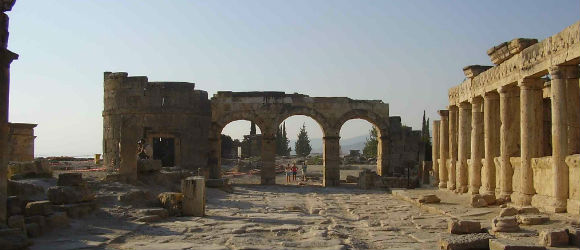The presence of a hot spring at Hierapolis and the spectacular calcium deposits from its water spilling over the nearby hillside suggest that there should be evidence of an early settlement there. The oldest Inscription found so far, however, indicates it was founded by Eumenes II, king of Pergamon, in the latter part of the second century B.C.; it soon became a busy industrial center.
Pagan worship in the city centered around Cybele, Apollo, Artemis, Men, Poseidon, and Pluto. Underneath the Temple of Apollo has been found the Plutonium, an opening in the earth from which a noxious gas still comes. The temple is between the pool where the hot spring rises and the large theater on the side of the hill. To the north along the rim of the plateau is a long avenue of tombs.
Traditionally St. Philip is connected with the early church in Hierapolis. Fairly recently Italian archeologlsts have discovered his Martyrium, an octagonal chamber forming a double cross surrounded by a square. This is almost due north of the theater, also on the side of the hill. It was a fifth century A.D. building and did not last much more than 100 years. No tomb was found with it although that was expected. There are several ruins of churches, one not far from the baths, one on the main road leading to the necropolis.
Hierapolis is listed in the New Testament along with Laodicea as the center of Epaphras’s work (Colos-sians 4:13). This was at the time Paul was writing to strengthen the message Epaphras was preaching and to condemn the “people who go in for self-mortification and angel-worship” (Colossians 2:18). Another less well-known resident of Hierapolis was Papias, a disciple of St. John and the author of the lost book called the Sayings of Jesus.
While Epaphras was is that area, a young slave was growing up in Hierapolis, a boy whose original name is unknown but whom we call by the Greek for “Acquired”, Epictetus. In his Discourses Epictetus often talks about the perfect missionary whose bed was the ground, whose only house the earth and sky and a shabby cloak, and who must love those who misuse him in the service of God. One wonders what the influence of those early Christians, many of whom were slaves themselves, was on this Stoic philosopher.
Hierapolis,


I saw this site after the perhaps more popular Ephesus and I have to say I like this one better. What it lacks in architectural magificence it more than makes up for by the vastness of the site, and just the pure volume of the ruins it encapsulates. I walked the length of this site from both its imposing gates…
The history of hierapolos is interesting and worth the visit to the sight. Throw in the amazing calcium pools and you can see why this is such a popular attraction.
You can walk through and sit in the calcium pools, for an additional 30 lira you can swim on the healing mineral pools that have remained the same for 1000s…
This place is well worth the trip. It was really hot on the day we visited, but inbetween trekking about the various sights, we took a break in the Antique baths (location of Cleopatras Pool) where they have a lovely covered cafe area with massive fans. A welcome break on a hot day. The calcium pools themselves are stunning, amazing…
Pamukkale with the ancient name Hierapolis is an amazing place that shouldn't be missed in this lifetime. It is an area known as a SPA from the 2nd century BC and protected by UNESCO. It is 20km away from Denizli city center, Turkey. The natural mineral water pools are known with their healing and refreshing effects. On top of the…
Pamukkale does not look like the post-cards – the cotton terraces are yellowish / brownish, water was cold. Although the geographic formation was pretty cool, my high expectations from looking at tour books/ internet had spoiled my actual experience.
Loved the walk through the ruins and the swim in the ancient Roman pool was wonderful and worth every cent. We then walk down through the terraced pools of Pamukkale and it was beyond anything I have ever experienced before. Extraordinary
If you would like to look at ruins of old city, you must visit Hierapolis. If you wish to see nature bath or swim there, you should visit Pamukkale. It was too hot in Hierapolis and too crouded in Pamukkale at day time. I would recommend start from 16:00.
I visited Pumakkale ten/twelve years ago and more recently last year. It has changed dramatically. The ancient ruins of necropolis (Hierapolis?) has been devastated, it was a more complete, beautiful christian ruins on my first visit but on my last visit all the hotels that were there have been removed because of local damage to the sulphur lakes, good idea…
Both the ancient Roman city of Hierapolis and Pamukkale are great places to visit if staying nearby on holidays. Pamukkale is amazing, if a bit too overcrowded. Also in the complex are Cleopatra's pools, which need to be paid for separately, and which again are very overcrowded. Hierapolis is quite a large complex, which includes a splendid Roman theatre. However,…
We thoroughly enjoyed Hierapolis soooo much to see.